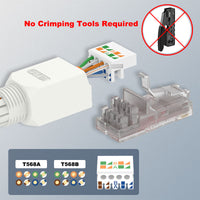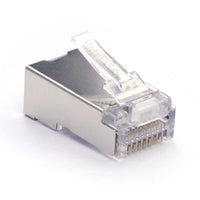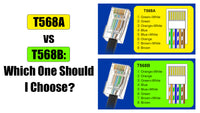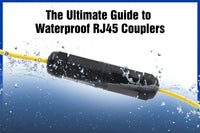If you’re a beginner to network installation, I guess you will be confused about terms such as RJ45, 8P8C, and modular plug. All of these terms are related to items that are attached to the end of Ethernet cables. We’re talking about all things about RJ45 connectors here to let you have a better understanding of them.
What is “RJ45”?
Do you know the meaning of “RJ45”? Let me explain it.
“RJ” is the abbreviation of “registered jack”, which originally means a standardized telecoms network interface for voice and data devices connection. It was first defined in the USCO (Universal Service Ordering Code) of Bell System and in the 1970s, it was licensed by FCC (Federal Communications Commission) to maintain the compatibility between customer devices and telephone service provider equipment. “45” means the listing number of networking interface standards.
What is an RJ45 Connector? RJ45 vs. 8P8C?
There are different types of modular connectors for telephone and network applications and the RJ45 is one kind of modular plug used in the network.
In fact, the RJ45 connector is a technically incorrect term, and the correct way to call it is “8P8C modular plug”. “8P8C” refers to “8 Positions and 8 Contacts”, which is often used at the end of Ethernet cables. A network patch cable is usually made of an Ethernet cable and two RJ45 connectors on both ends.
Components
This tiny network connector is made of several important parts.
- Plastic Housing: A good-quality Ethernet connector usually features a plastic housing made of high-performance PC materials. The more transparent the design, the better its material.
- Eight Contacts: Not all RJ45 connectors on the market feature gold-plated contacts. But RJ45 connectors with gold-plated contacts offer better corrosion and oxidation resistance. There are two types of gold-plated contacts: two-prong and three-prong contacts. RJ45 connectors with two-prong contacts are designed for stranded cable wires, whereas three-prong connectors can be used in both solid and stranded wires. Three-prong connectors can help well fix the cable wire for a stable connection.
- Strain Latch and Retaining Latch: The strain latch is designed to make the RJ45 connector snap in the interface and avoid being loose. Most Ethernet connectors feature a strain latch and a rectangular hole and if you use these connectors, you need to use the specific crimping tool. The retaining latch is designed to fix the network cable and prevent it from falling off. Remember to press the retaining latch when inserting or pulling out the modular plug.
For some scenarios full of EMI and RFI, shielded RJ45 connectors are used and they feature a metal shielding structure to help avoid interference.
Different RJ45 connectors have different types of insulated conductor holes. Eight insulated conductor holes of Cat5 connectors are arranged neatly, while Cat6 connectors generally have a staggered pin layout. But this is not the standard and it depends on different manufacturers.

RJ45 Connector Pinout
As is known to all, RJ45 connectors are made to connect Ethernet cables. There are two wiring standards for terminating network cables with RJ45 connectors: T568A and T568B. The main difference between these two color codes is the interchange of orange and green wires. T568B is more popular than T568A, but either one is OK according to your own requirements. All you need to do is choose one wiring standard and then insist on it. For more details about T568A and T568B, see T568A vs T568B: Which One Should I Choose?
RJ45 Connector Types
To meet the different needs of network installation, RJ45 connectors can be classified into various types. There are Cat5e connectors, Cat6 connectors, Cat6a connectors, Cat7 connectors that are designed to be compatible with different categories of network cables. RJ45 connectors can also be divided into other types according to applications and designs. Do you know the types of RJ45 connectors? Read on to know more details.
Standard vs. Pass-through RJ45 Connectors
Standard RJ45 connectors can also be named as non-pass-through RJ45 connectors, which are usually referred to as 8P8C modular plugs. Pass-through RJ45 connectors allow the network cable wires to pass out of the connector body. Compared to standard RJ45 connectors, pass-through RJ45 connectors are easy to keep Ethernet cable wires aligned before terminating the connectors. In addition, pass-through RJ45 connectors are easier to operate, ideal for novices or DIYers. Pass-through RJ45 connectors usually require a specific crimping tool.
#Tips: Angled flush cutting makes it easier to install both non-pass-thru and pass-thru connectors.

Shielded vs. Unshielded RJ45 Connectors
Unshielded RJ45 connectors have a plastic housing, while shielded RJ45 connectors usually feature a metal shield to avoid too much electromagnetic interference (EMI).
The metal shielding structure is usually plated with nickel or gold. But a nickel-plated shielding structure is more common on the market.
Remember not to use a shielded RJ45 connector on an unshielded network cable, as it may affect the connection. Shielded RJ45 connectors are often paired with shielded Ethernet cable for maximum performance. If you use an unshielded cable, choose an unshielded connector, and if the cable is shielded, use the shielded RJ45 connector.

Standard vs. Toolless RJ45 Connectors
Standard RJ45 connectors usually require a professional tool - an RJ45 crimping tool. A toolless RJ45 connector or field termination plug can be easily terminated without a crimping tool.
Toolless connectors can be used in emergent situations and in field termination. For example, they are designed for quick connection in the field and for frequently moved cabling. What’s more, toolless RJ45 connectors can also be reused a few times without affecting the data transmission.

Single-piece vs. Two-piece RJ45 Connectors
Compared to single-piece RJ45 connectors, two-piece RJ45 connectors have an additional load bar, designed to help align eight wires for easy and quick wiring. In addition, the load bar can also improve RJ45 connectors’ resistance to interference.

The Inner Working Principle
When you connect the RJ45 connector to the end of the Ethernet cable and plug it into the Ethernet port, do you know how it works?
There are eight gold-plated contacts inside an RJ45 network connector and each one is separated by insulating plastic materials. Some connectors feature two-prong contact pins, and some come with three-prong contact pins. These prongs will “bite” into every wire when the RJ45 connectors are pressed by a crimping tool. Once the RJ45 network connector is placed into the Ethernet port, the female and male connectors will make contact with each other. Then, data and signal transmission began to flow through the Ethernet cable.

Applications
Never underestimate the power of these tiny things. These connectors can be used to connect a computer to a server, router, TV, or any other device to make a local area network. RJ45 connectors are essential parts in the cabling system, which are often used in large data centers or server rooms. Besides, they can also be used in the factory, such as Industrial Process Control and Quality Control Systems. These Ethernet connectors allow for stable, high-speed, and secure data transmission when you make the system connect to the Internet.

How to Choose the Best RJ45 Connector?
Knowing about RJ45 connector types, do you feel a little confused about how to choose RJ45 connectors? How do you know the quality of an RJ45 connector and which one should you get? You will definitely get the answer in this article.
RJ45 connectors are often used in low-voltage applications, so it is very important to choose the high-quality ones for a structured cabling system. Let's walk through how to distinguish the quality of RJ45 connectors.
Firstly, look at the appearance.
A high-quality Ethernet connector usually features a bright, transparent, and smooth housing. This precision device is made of high-quality materials featuring a low coefficient of thermal expansion (CTE), accurate size, and excellent stability, which can adapt to complicated environments and boast a long service life. The housing of RJ45 connectors is generally made of Polycarbonate (PC). But please note that PC is not always transparent and RJ45 connectors can be different colors.
When you buy a packet of connectors, the first thing you can do is to shake it and hear if the sound is crispy. A clear sound means that the material has a high density and purity.
Next, test the retaining latch.
An excellent retaining latch can be folded over 180 degrees several times, and it can return to its original shape with good elasticity. If the retaining latch is broken when bent over 180 degrees less than 15 times, this RJ45 connector is not so good.
Finally, check eight contact pins.
Most RJ45 connectors on the market have contact pins made of bronze or phosphor bronze because they are tough enough to make contact with wires.
In International Standard IEC 60603, an RJ45 connector should feature 50μ gold-plated contact pins that can be inserted more than 1,000 times. Gold is plated on the contact pins as it is one of the best conductors for electricity. 50μ gold-plated contact pins are designed to avoid data loss and corrosion, so you should pay attention to the thickness of gold plating for better performance.
Some poor-quality contact pins are made of solid copper, which is prone to oxidation and blackening if they have been exposed to air for a long time. If you’re hunting for a high-performance RJ45 connector, choose one with thick, gold-plated contact pins for high-speed and stable data transmission.
What’s more, there are also two-prong contacts and three-prong contacts. Three-prong contacts can be more stable, which can also help fix cable wires tightly.
With the above guide, I guess you will be clearer about choosing the best quality RJ45 network connectors. But do you know how to choose the correct RJ45 connector according to the category of Ethernet cables?
Ethernet cables vary in insulated conductor diameter, OD (outside diameter), and copper conductor AWG gauge, so you should know what RJ45 connectors can be used with different network cables. Good manufacturers and brands will have detailed specifications on each listed product.
We have some tips for you:
- Pass-through RJ45 connectors are strongly recommended for CAT6 and CAT6A Ethernet cables.
- Pair RJ45 connectors with strain relief boots for a stable network connection. Strain relief boots can also help protect the cable from dust and water.
- Buy connectors from different vendors and buy more connectors than you need to ensure that the RJ45 connectors can work well with your network cables.
- There are slight differences in the size of network cable wires because of different production processes, so you’d better take a look at the RJ45 connector specification to see the diameter of network cables that it can fit up.
How to: Assembly A Shielded RJ45 Connector on CAT6A CAT7 Ethernet Cable?
For beginners, two-piece shielded RJ45 connectors can be a bit difficult to operate. Don’t worry, our step-by-step tutorial can walk you through the process.
Step 1: Use a wire stripper to strip the Ethernet cable carefully.

Step 2: Use the cable jacket to straighten eight wires.

Step 3: Arrange the wires according to T568A or T568B wiring standard. Either is OK and you can choose one based on your needs.

Step 4: Cut the wires carefully to the required length. Angled flush cutting is helpful for wires to pass through the load bar.

Step 5: Let the wires pass through holes in the load bar.

Step 6: Cut off excess wires.

Step 7: Insert wires with load bar into the housing.

Step 8: Use the professional crimping tool to crimp the RJ45 connector.

Step 9: Wielding the shield braiding and make the buckle as close as possible.

Step 10: Crimp the fixed buckle.

Step 11: Use the RJ45 tester to test if the cable can work well.

FAQs
What is an RJ45 connector used for?
RJ45 connectors are normally used at two ends of Ethernet cables to help connect your computer to a system based on LAN (Local Area Networks).
Which cable uses RJ45 connectors?
Ethernet cables, also known as network cables or LAN cables. RJ45 connectors are usually used on both ends of Ethernet cables.
Are all RJ45 connectors the same?
No, RJ45 connectors can be classified into different types, e.g. standard RJ45 connectors or pass-through RJ45 connectors; and shielded RJ45 connectors or unshielded RJ45 connectors.
For more information on this topic, you can keep up on our blogs. While VCELINK offers general and basic information for our customers and other visitors to the website, it’s not professional advice.








Very usefull information
Useful idea
my Lan cable has 8 plain coloured conections Brown Blue Black Red Yellow Green Grey and orange.
how can i find the respective pin numbers for RJ45 conections, Also the cable is shielded but my rack is not should I abondon the shield at both ends ie the wallplate and the jack.
Thank you for your help on this
Patrick
Excellent presentation, well done!